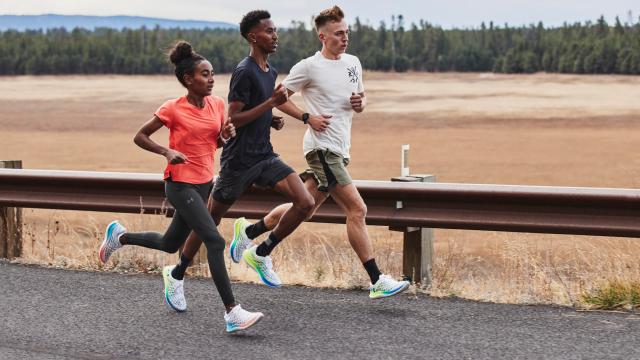Whether you’re a longtime running fan, someone who picked up the habit during lockdown or someone who is just getting started with the sport, the question of how to develop speed when running is a pretty common one.
Seeing as I’ve never run a kilometre at anything remotely considered a ‘fast’ speed, I reached out to an expert for a little guidance here. Samantha Shearman is a physiotherapist, sports scientist, founder of 10 Weeks to Stronger Running app and an ambassador for the UA All Out Mile challenge.
If you’re wondering, the UA All Out Mile is an international challenge running (lol) from June 1 to June 5 in which you’re asked to attempt a 1-mile or 1.6 km run, using UA MapMyRun, at your fastest speed. You can attempt it as many times as you like during the challenge period and your fastest time will be recorded on the leaderboard.
For those keen to improve their run speed, or to get training ahead of the All Out Mile comp, here are Shearman’s top tips.
How to improve your running speed

High-intensity interval sessions are your friend
Over email, Shearman explained that “in order to run a faster mile, a runner needs to train both their anaerobic system (which supplies short term, explosive energy) and aerobic system (which utilises oxygen to provide energy, think of it as our engine).”
She suggested introducing training styles into your workout like the below:
- Fartlek sessions – e.g. continuous running with periods of faster paced running
- Speed Intervals – e.g. maintain a quick pace for a short period of time, with a full rest in between
- Hill Repeats – e.g. repeating intervals of running up a challenging gill
- Tempo sessions – e.g continuous running at an intensity between our aerobic and anaerobic thresholds. This is approximately 85-90% max heart rate.
It’s important to remember here, however, that while high-intensity training is important for building speed, so too is adequate rest. Shearman said that “a runner should also include easy, steady-state sessions” in their training program “to build their aerobic base.”
“Building a strong aerobic base can too improve high-intensity performance, as it raises your VO2max (maximum amount of oxygen that is consumed by the body), lactate threshold (the point where lactate starts to accumulate blood) and running economy (how efficient the body is using oxygen),” she added.
Don’t skip strength training
We’ve written about the power of strength training for running before and Shearman certainly agrees.
“Research shows that runners benefit from lifting high load low repetition weights to improve their running performance,” she said.
She explained that elements like the generation of more power, increased stimulation and coordination of muscles and better elastic energy “leads to a more powerful stride” for runners.
“Strength training has been shown to improve time trial performance in runners, as we as improve running economy. Importantly, it can help to reduce injury risk,” Shearman stressed.
When introducing strength training as a means of helping aid your speed when running, Shearman suggested two sessions per week using “compound movements such as squats and deadlifts, single leg exercises to improve stability – and make sure to never neglect the calves.”
Don’t forget the warm-up
Ah, the most neglected element of fitness ever (except for a cool down, maybe).
Here, Shearman said that “the last piece of the puzzle is ensuring you complete a sufficient warm up so your body can perform at its best” when running for speed.
“Warming up wakes up the nervous system, elevates your heart rate, improves joint range of motion, muscle temperature and tendon elasticity so your body is ready to go at full capacity right from the start,” she explained.
If you need some guidance on where to start for your warm-up she suggested:
- Light jogging (10-15 min)
- Dynamic stretching: such as leg swings, hip openers, dynamic walking lunges
- Running technique drills: such as A- Skips, Bottom Kicks, High Knees
- Strides: short 50-100m accelerations building to 95% of max speed
Now go forth and get yourself a PB. Oh, and if you need some new running shoes, check out this review we wrote a while back.

Leave a Reply
You must be logged in to post a comment.